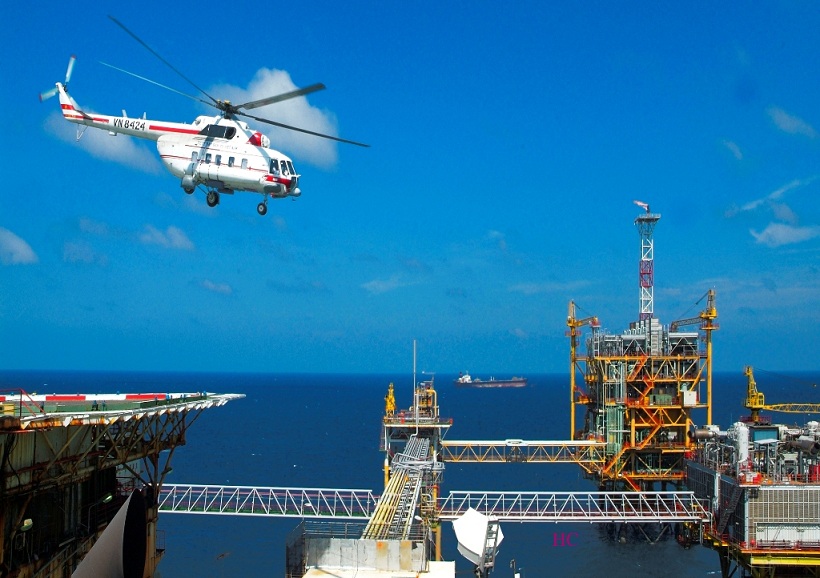VietNamNet Bridge - Most oil field exploitation in Vietnam is in the final stage. This has led to a decline in oil & gas output.
Bach Ho (White Tiger) oil field, which makes up over 60 percent of PetroVietnam’s output, has entered the last stage, according to Thanh Nghia, general director of Vietsovpetro, a joint Russian-Vietnamese oil and gas exploiter, who spoke at a recent event of the oil & gas industry.
“Bach Ho can be exploited for four to five more years,” Nghia said. “The plan to maintain the annual exploitation output of 4 million tons is a big challenge.”
He went on to say that 2017 saw the lowest ever oil & gas reserves increase. In 2018, PetroVietnam assigned Vietsovpetro to drill for exploration of 10 oil fields, while it drilled four fields only last year.
“If we don’t step up exploration, we won’t have oil output in upcoming years. However, the oil fields we plan to develop are mostly small. There is no other large oil field like Bach Ho,” he said.
The manager of PVEP also said 2017 was the third consecutive year which saw the oil price stay at levels lower than PVEP’s expectations.
He expressed concern over the decline in natural output, the limited exploration activities and the lack of reasonable policies for explorers.
Deputy general director of PetroVietnam Nguyen Quynh Lam has confirmed it is difficult to increase the reserves.
While PetroVietnam pays trillions of dong in tax to the state budget, it did not receive sufficient money for exploration activities in 2017.

“The lack of exploration will lead to insufficient reserves. As a result, oil refineries won’t have crude oil, while fertilizer plants won’t have gas to run, and workers won’t have jobs,” he warned.
According to PetroVietnam’s general director Nguyen Vu Truong Son, in the past, PetroVietnam drilled 30-40 fields in its exploration plan, which cost $2-2.5 billion, which helped increase 35-40 million tons of equivalent oil.
However, since 2015, the budget for the activities has dropped five times.
“As a result, the annual reserves increase has declined sharply. It was 4 million tons in 2017, the lowest level in history,” Son said.
A PetroVietnam report showed that the oil & gas reserves increase in 2017 was much lower than targeted.
The targets are 20-30 million tons a year in Vietnam and 8-12 million tons overseas (28-42 million tons in total). However, PetroVietnam could not fulfill the plan in 2016 and 2017 with 16.66 million and 4 million tons of equivalent oil, respectively.
Bach Ho (White Tiger) oil field, which makes up over 60 percent of PetroVietnam’s output, has entered the last stage, according to Thanh Nghia, general director of Vietsovpetro, a joint Russian-Vietnamese oil and gas exploiter, who spoke at a recent event of the oil & gas industry.
“Bach Ho can be exploited for four to five more years,” Nghia said. “The plan to maintain the annual exploitation output of 4 million tons is a big challenge.”
He went on to say that 2017 saw the lowest ever oil & gas reserves increase. In 2018, PetroVietnam assigned Vietsovpetro to drill for exploration of 10 oil fields, while it drilled four fields only last year.
“If we don’t step up exploration, we won’t have oil output in upcoming years. However, the oil fields we plan to develop are mostly small. There is no other large oil field like Bach Ho,” he said.
The manager of PVEP also said 2017 was the third consecutive year which saw the oil price stay at levels lower than PVEP’s expectations.
He expressed concern over the decline in natural output, the limited exploration activities and the lack of reasonable policies for explorers.
Deputy general director of PetroVietnam Nguyen Quynh Lam has confirmed it is difficult to increase the reserves.
While PetroVietnam pays trillions of dong in tax to the state budget, it did not receive sufficient money for exploration activities in 2017.

According to PetroVietnam’s general director Nguyen Vu Truong Son, in the past, PetroVietnam drilled 30-40 fields in its exploration plan, which cost $2-2.5 billion, which helped increase 35-40 million tons of equivalent oil.
However, since 2015, the budget for the activities has dropped five times.
“As a result, the annual reserves increase has declined sharply. It was 4 million tons in 2017, the lowest level in history,” Son said.
A PetroVietnam report showed that the oil & gas reserves increase in 2017 was much lower than targeted.
The targets are 20-30 million tons a year in Vietnam and 8-12 million tons overseas (28-42 million tons in total). However, PetroVietnam could not fulfill the plan in 2016 and 2017 with 16.66 million and 4 million tons of equivalent oil, respectively.
The lack of exploration will lead to insufficient reserves. As a result, oil refineries won’t have crude oil, while fertilizer plants won’t have gas to run, and workers won’t have jobs
vietnamnet.vn
Relate Threads

